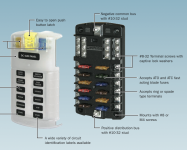Edited to add: A friend happened to be looking over my shoulder and so I now think I have the answer; but perhaps this will still help someone else with my same question (and of course correct me if this is wrong). I'll put my "answer" at the bottom.
I'm preparing an order for "goodies" so that I can upgrade the wiring leading from the lazarette up to the behind-helm area. Currently, I have one "thinnish" wire heading up there that goes to one fuse block (stock setup).
So, I was planning to to run a #6 red cable from the lazarette up to the behind-helm area to supply two new fuse blocks (because I want more fuse locations than a single 12-fuse block will provide). Then run a #6 black wire back to the negative bus in the lazarette.
My question cropped up because I realized... wait... if I'm going to have two fuse blocks I have to supply them both somehow (one #6 cable is enough to carry the loads for both in terms of gauge). So how do I handle the wiring at the fuse block end? Do I just run the main feed cable to one of them, and then to the other one.... in series.... somehow? What exactly do I do with the positive and negatives "in the middle"? I get that one positive cable runs forward, and then one negative runs back to the laz, but am not sure how to handle the "in betweens" to connect the two fuse blocks.
This is the type of blocks I plan to use, btw:

Edited to add: So okay, I think I run the red feed wire up to the positive terminal on the first fuse block, then a small red "jumper" from there to the positive terminal on the second fuse block, where it can dead-end. And I do the same thing with a black cable to the negatives. So they are in parallel. This looks obvious once I saw it drawn out, of course! :wink: I'm probably fuzzy headed from trying to make up my shopping list of the various lugs, crimps, ring-terminal sizes, and etc!
Thanks,
Sunbeam
I'm preparing an order for "goodies" so that I can upgrade the wiring leading from the lazarette up to the behind-helm area. Currently, I have one "thinnish" wire heading up there that goes to one fuse block (stock setup).
So, I was planning to to run a #6 red cable from the lazarette up to the behind-helm area to supply two new fuse blocks (because I want more fuse locations than a single 12-fuse block will provide). Then run a #6 black wire back to the negative bus in the lazarette.
My question cropped up because I realized... wait... if I'm going to have two fuse blocks I have to supply them both somehow (one #6 cable is enough to carry the loads for both in terms of gauge). So how do I handle the wiring at the fuse block end? Do I just run the main feed cable to one of them, and then to the other one.... in series.... somehow? What exactly do I do with the positive and negatives "in the middle"? I get that one positive cable runs forward, and then one negative runs back to the laz, but am not sure how to handle the "in betweens" to connect the two fuse blocks.
This is the type of blocks I plan to use, btw:

Edited to add: So okay, I think I run the red feed wire up to the positive terminal on the first fuse block, then a small red "jumper" from there to the positive terminal on the second fuse block, where it can dead-end. And I do the same thing with a black cable to the negatives. So they are in parallel. This looks obvious once I saw it drawn out, of course! :wink: I'm probably fuzzy headed from trying to make up my shopping list of the various lugs, crimps, ring-terminal sizes, and etc!
Thanks,
Sunbeam
